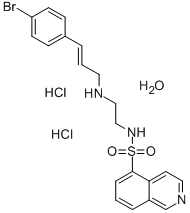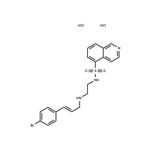H-89 dihydrochloride hydrate has been used in the inhibition of protein kinase A in Leydig cells, primary calvarial osteoblasts (pOBs), rat granulosa cell line (LH-15 cells) and human umbilical vein endothelial cells (HUVECs).
Selective inhibitor of Protein Kinase A (cyclic AMP-dependeant Protein Kinase) with an inhibitory constant of
0.0048 uM.
ChEBI: N-[2-(4-bromocinnamylamino)ethyl]isoquinoline-5-sulfonamide dihydrochloride is a hydrochloride salt prepared from N-[2-(4-bromocinnamylamino)ethyl]isoquinoline-5-sulfonamide and two equivalents of hydrogen chloride. It has a role as an EC 2.7.11.11 (cAMP-dependent protein kinase) inhibitor. It contains a N-[2-(4-bromocinnamylamino)ethyl]isoquinoline-5-sulfonamide(2+).
h 89 2hcl is a potent pka inhibitor. in a cell-free assay, the ki of h 89 is 48 nm, 10-fold selective for pka than pkg and 500-fold greater selectivity than pkc, mlck, calmodulin kinase ii and casein kinase i/ii [1].[1]. chijiwa t, mishima a, hagiwara m, et al. inhibition of forskolin-induced neurite outgrowth and protein phosphorylation by a newly synthesized selective inhibitor of cyclic amp-dependent protein kinase, n-[2-(p-bromocinnamylamino) ethyl]-5-isoquinolinesulfonamide (h-89), of pc12d pheochromocytoma cells[j]. journal of biological chemistry, 1990, 265(9): 5267-5272.[2]. lochner a, moolman j a. the many faces of h89: a review[j]. cardiovascular drug reviews, 2006, 24(3‐4): 261-274.[3]. lee t h, linstedt a d. potential role for protein kinases in regulation of bidirectional endoplasmic reticulum-to-golgi transport revealed by protein kinase inhibitor h89[j]. molecular biology of the cell, 2000, 11(8): 2577-2590.
H-89 dihydrochloride hydrate is a selective inhibitor of protein kinase A (PKA). It also inhibits potassium (K+) current in rat myocytes. It mediates Na+ transport by interacting with α subunits of epithelial Na+ channel (ENaC).
in pc12d cells, pretreatment with h-89 dose-dependently inhibited the forskolin-induced protein phosphorylation, with no influence in intracellular cyclic amp levels. in pc12d cells, h-89 significantly inhibited the forskolin-induced neurite outgrowth. in pc12d cells, pretreatment with h-89 (30 μm) strikingly inhibited camp-dependent histone iib phosphorylation activity in cell lysates while showed no effects on other protein phosphorylation activity such as cgmp-dependent histone iib phosphorylation activity [1]. h 89 was a potent and selective pka inhibitor with ki of 48 nm in a cell-free assay [2]. h89 also inhibited s6k1, msk1, pka, rockii, pkbα and mapkap-k1b kinases with ic50 of 80, 120, 135, 270, 2600 and 2800 nm, respectively [2]. in the hypotonic medium, 50 μm h89, a concentration commonly used to inhibit pka, prevented the redistribution response. in normal medium, h89 (50 μm) induced the redistribution of ergic 53 to the er by 20 min [3].

